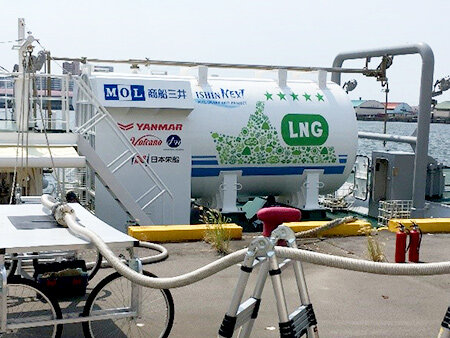Japan first: LNG-fueled tugboat uses carbon-neutral LNG
Mitsui O.S.K. Lines, Ltd. and its group company Nihon Tug-Boat Co., Ltd. announced that the Nihon Tug-Boat-operated LNG-fueled tugboat Ishin was supplied for the first time with carbon-neutral LNG (CNLNG) fuel by Osaka Gas Co., Ltd. and Daigas Energy Co., Ltd. on September 1, 2021. This marks the first use of CNLNG as vessel fuel in Japan.

CNLNG for the Ishin was supplied to the tugboat using the truck to ship method at the wharf in Sakai Senboku Port, Osaka. The "carbon neutral" designation means that all greenhouse gases (GHGs), generated throughout the life cycle of natural gas extraction, liquefaction, transport, production, and combustion processes, were offset by credit (Note 3), and CNLNG is expected to gain wide adoption in the future for general use as well as vessel fuel (Note 4).
The tugboat Ishin is owned by MOL, and has been operated by Nihon Tug-Boat since February 2019. It has been supplied with LNG fuel from Daigas Energy since the beginning of the operation (Note 5). On this occasion, Daigas Energy and Nihon Tug-Boat signed a memorandum of understanding (MoU) for supply of CNLNG over several years.
Moves to tighten regulations on exhaust emissions from merchant vessels have accelerated in recent years. In April 2018, International Maritime Organization (IMO) adopted an initial strategy on the reduction of GHG emissions from international shipping by at least 50% by 2050 compared to 2008 levels, and to phase out GHG emissions from international shipping as soon as possible, in this century.
The goal of the MOL Group is to achieve net zero GHG emissions by 2050, as set out in the "MOL Group Environmental Vision 2.1" (Note 6), announced in June 2021. The group set the "Adoption of Clean Alternative Fuels" strategy (Fig. 1) to realize the goal, and plans to introduce about 90 LNG-fueled vessels by 2030. The Ishin is MOL's first LNG-fueled vessel, and the group continues its proactive push on new initiatives to reduce GHG emissions.
MOL aims to promote the wider use of LNG-fueled vessels while working to adopt new alternative fuels such as ammonia and conducting research and development on the use of synthetic methane, which is expected to contribute to further GHG reduction. It not only strives to reduce GHG emissions generated from its own operations, but also to meet the needs of customers and society to reduce the environmental impact of its activities.

- ExxonMobil halts 1-Bft3d blue hydrogen project in Texas
- Aramco and Yokogawa commission multiple autonomous control AI agents at Fadhili gas plant
- Ukraine will resume gas imports via Transbalkan route in November
- Mitsubishi to inject $260 MM into Brunei LNG project
- Freeport LNG (U.S.) on track to take in more natgas on Thursday after unit outage



Comments